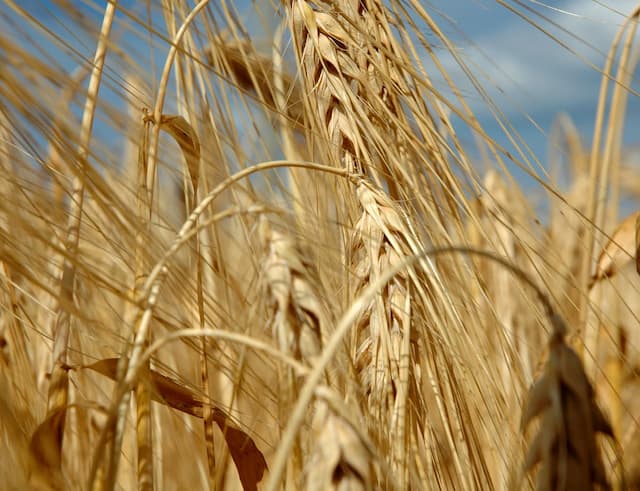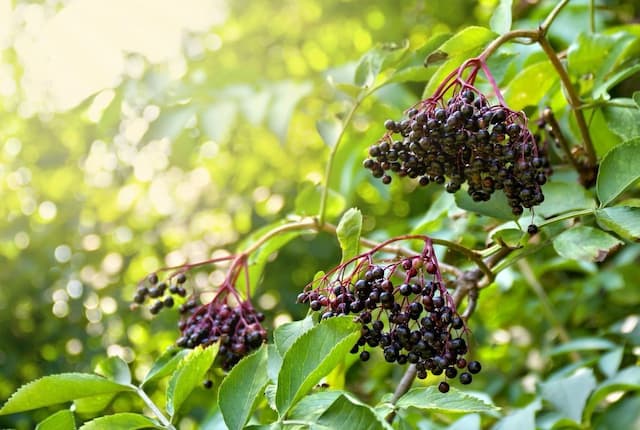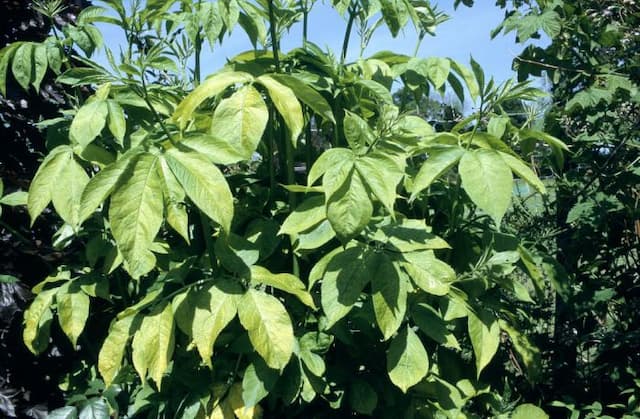Burkwood Viburnum Viburnum × burkwoodii 'Anne Russell'

ABOUT
The Anne Russell viburnum is a delightful ornamental plant, beloved for its splendid display of fragrant flowers and attractive foliage. This plant is renowned for its flower clusters, known as inflorescences, which bloom abundantly in the spring. These blossoms are typically white or lightly pink, emerging from pink buds and exuding a rich, sweet aroma that can perfume the surrounding area. The leaves of this viburnum add to its charm with a glossy, deep green color that creates a lovely contrast against the soft hue of the flowers. The foliage has an ovate shape, which means they are somewhat egg-like, with a pointed tip and rounded base. They possess a smooth texture and often have a slightly wavy edge. Moreover, the leaves are arranged in an opposite fashion on the stems, providing a symmetrical appearance. After the blooming season, the Anne Russell viburnum may bear fruit. These fruits can provide visual interest as well, with a color transition from red to black as they ripen. The presence of these fruits can also attract birds and wildlife to the garden. Overall, the Anne Russell viburnum contributes an elegant aesthetic to any landscape setting, offering multi-season interest with its alluring flowers, lustrous leaves, and the occasional display of fruits. Its adaptability and pleasing appearance make it a popular choice for gardens desiring a touch of spring fragrance and a year-round display of natural beauty.
About this plant
 Names
NamesFamily
Adoxaceae.
Synonyms
Burkwood Viburnum, Anne Russell Viburnum.
Common names
Viburnum × burkwoodii 'Anne Russell'.
 Toxicity
ToxicityTo humans
Burkwood Viburnum is generally not considered toxic to humans. However, as with many plants, individual sensitivity can vary, and some people may experience mild stomach upset or skin irritation if they ingest or handle parts of the plant. It is always a good practice to avoid ingesting parts of ornamental plants due to potential individual reactions.
To pets
Burkwood Viburnum is also not widely known to be toxic to pets. However, ingestion of large quantities of any plant material may cause gastrointestinal discomfort, such as vomiting or diarrhea, due to the mechanical irritation of the plant matter, rather than chemical toxicity. If a pet exhibits signs of distress after consuming any part of the plant, it is advisable to consult a veterinarian.
 Characteristics
CharacteristicsLife cycle
Perennials
Foliage type
Semi-deciduous
Color of leaves
Green
Flower color
Pink
Height
6-8 feet (1.8-2.4 meters)
Spread
6-8 feet (1.8-2.4 meters)
Plant type
Shrub
Hardiness zones
5
Native area
Cultivar
Benefits
 General Benefits
General Benefits- Ornamental Appeal: Anne Russell Viburnum features attractive, fragrant flowers that enhance garden aesthetics in spring.
- Wildlife Attraction: The flowers provide nectar for pollinators, while berries attract birds and other wildlife.
- Year-Round Interest: Offers multi-seasonal interest from spring blooms, summer foliage, and sometimes colorful fall leaves or berries.
- Screening & Privacy: Dense growth habit makes it excellent for use as a privacy hedge or screen.
- Low Maintenance: Requires minimal care once established, making it ideal for gardeners of all skill levels.
- Drought Tolerance: Once established, it has moderate drought resistance, reducing the need for frequent watering.
- Adaptable: It can thrive in a variety of soil types, provided they are well-draining.
- Hardiness: This plant is generally hardy in the climates where it is recommended, withstanding typical winter conditions.
 Medical Properties
Medical PropertiesThis plant is not used for medical purposes.
 Air-purifying Qualities
Air-purifying QualitiesThis plant is not specifically known for air purifying qualities.
 Other Uses
Other Uses- Creating perfumes: The fragrant flowers of Anne Russell viburnum can be distilled to produce essential oils for perfumery.
- Educational tool: Botany students and educational programs can use this plant to study hybrid plant characteristics and crossbreeding results.
- Sound barrier: Planted in dense rows, Anne Russell viburnum can help reduce noise pollution due to its thick foliage.
- Privacy screens: Its dense growth habit makes it ideal for creating private spaces in gardens and parks.
- Windbreaks: When planted in a row, these shrubs can protect smaller plants from strong winds.
- Photography: The plant's attractive appearance can be a subject for botanical photographers and nature enthusiasts.
- Art inspiration: Artists can use the visually appealing flowers and foliage of this plant as a muse for paintings, drawings, and other art forms.
- Culinary decoration: Although not commonly used for consumption, the flowers could be used as a non-toxic decorative element for plating dishes.
- Horticultural training: The Anne Russell viburnum is a good candidate for training in pruning techniques and shaping in horticultural classes.
- Biodiversity enhancement: Planting this shrub can contribute to garden biodiversity, providing habitat and food for various species of birds and insects.
Interesting Facts
 Feng Shui
Feng ShuiThe Burkwood Viburnum is not used in Feng Shui practice.
 Zodiac Sign Compitability
Zodiac Sign CompitabilityThe Burkwood Viburnum is not used in astrology practice.
 Plant Symbolism
Plant Symbolism- Renewal: Viburnum typically blooms in the spring, symbolizing new beginnings and the renewal of life.
- Protection: In some cultures, viburnum represents protection due to its sturdy nature and the way some species are used in hedges and landscaping to guard properties.
- Beauty: 'Anne Russell', with its beautiful and fragrant blooms, is often associated with the concept of beauty and the pleasure one finds in visual appeal.
 Water
WaterThe Anne Russell Viburnum should be watered deeply to ensure the roots can access moisture, especially during dry spells. In the first growing season, it's critical to maintain even moisture, watering weekly with about 1 inch of water or enough to saturate the root zone. Once established, Anne Russell Viburnum can tolerate some drought, but it performs best when watered every two to three weeks with 1 to 1.5 gallons per plant, depending on the weather conditions and soil drainage. Overwatering or poor drainage can lead to root rot, so ensure the soil is well-draining.
 Light
LightAnne Russell Viburnum thrives in full sun to partial shade. The ideal location would provide direct sunlight for at least six hours a day, although this plant can also do well in slightly shaded areas. Avoid deep shade since it can result in fewer flowers and a leggy growth habit.
 Temperature
TemperatureAnne Russell Viburnum is hardy and can withstand a wide temperature range. It prefers temperatures between 60°F and 75°F for optimal growth but can survive in temperatures as low as 0°F and as high as 90°F. However, it's important to protect the plant from extreme temperatures to prevent damage to the foliage and blossoms.
 Pruning
PruningPrune Anne Russell Viburnum immediately after it finishes flowering to maintain the desired shape and size, and to promote next year's blooms. Cut back any dead or diseased branches, and thin out old wood every few years to rejuvenate the plant. Ideally, pruning should be done annually, but it can withstand less frequent trimming if necessary.
 Cleaning
CleaningAs needed
 Soil
SoilAnne Russell Viburnum prefers well-draining soil with high organic content, ideally a mix of loam, peat, and perlite or sand to ensure good drainage. A soil pH range of 5.5 to 6.5 is optimal for this shrub.
 Repotting
RepottingAnne Russell Viburnum, if grown in containers, does not require frequent repotting and can be repotted every 3-5 years or when it becomes root-bound.
 Humidity & Misting
Humidity & MistingAnne Russell Viburnum prefers average humidity conditions and can tolerate the humidity levels typically found in most outdoor garden environments.
 Suitable locations
Suitable locationsIndoor
Anne Russell Viburnum is hard to grow inside; opt for outdoor planting.
Outdoor
Plant Anne Russell Viburnum in well-draining soil, partial sun.
Hardiness zone
Anne Russell Viburnum is suitable for USDA zones 5-8.
 Life cycle
Life cycleViburnum × burkwoodii 'Anne Russell', commonly known as Burkwood Viburnum, begins its life cycle when a seed germinates in suitable soil conditions, typically during spring or early summer. The seedling stage is characterized by the emergence of a radicle and plumule, which develop into the root system and shoots respectively. As it grows, the plant enters the vegetative stage, during which leaves expand, branches form, and the root system strengthens, supporting the plant's increasing size. Following the vegetative stage, the Burkwood Viburnum reaches maturity and enters the reproductive stage, marked by the development of fragrant, showy flowers, usually around spring. These flowers are pollinated by insects, leading to the formation of small, berry-like fruit that contains seeds, thus completing the reproductive cycle. As a perennial shrub, once maturity is reached, the plant can reproduce annually for many years before eventually senescing.
 Propogation
PropogationPropogation time
Spring to Early Summer
The Viburnum × burkwoodii 'Anne Russell', commonly known as the Anne Russell viburnum, is often propagated through semi-ripe cuttings taken in late summer. You would select a healthy stem that has started to harden but is not yet fully woody. From this stem, cut a section of about 4 to 6 inches (10 to 15 cm) in length, making sure to include at least two sets of leaves. The lower leaves are removed, and the cut end can be dipped in a rooting hormone to encourage root development. Afterward, the cutting is placed in a pot filled with a mix of peat and perlite or a similar rooting medium. The pot should be kept under high humidity and in indirect light until roots have established, after which it can be gradually acclimated to normal growing conditions and eventually transplanted outdoors.




![Elder [Black Tower]](/_next/image?url=https%3A%2F%2Fplants-admin.emdemapps.com%2Fimages%2Fplants%2F%2Fimages%2F604b5cad99578.png&w=640&q=75)




